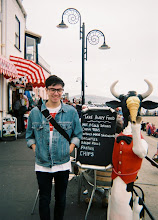Richard Learoyd's images are quietly unique. He captures his subjects with a shallow focus and soft, subtle colours and tones through a particular and somewhat unusual method, utilising a modern Camera Obscura, a camera the size of a room. The camera itself is fixed, as opposed to the traditional camera which is brought to a scene or an object to document it, instead, with Learoyd's camera the objects are brought to it. This also adds to the impression of crystalline moments captured outside of time, there is no constantly shifting and changing background which is captured, rather, the beautiful clear images which seem removed from the world outside the rooms of the camera, his images are 'sustained within their own hermetic condition'. His subjects are intimate, ranging from straight portraits to tableaux of dead animals, with compositions which have been described as 'artless' yet 'belie complex and restrictive rules dictated by the physics and optics of light' (see bibliography at end for consulted sources).
His images hold a quality that is so removed from context and temporality perhaps because the very method by which they are made dates back to the dawn of photography. Described as carrying 'visual echoes of the past' the limitations of the camera create a sense of stillness and serenity, complete with shallow focus and vignettes akin to the low-tech approach of modern Holga users as in the image below. (Richard Learoyd, 'Agnes with Eyes Closed', 2007. Museum no. E.421-2008)

Learoyd's images are also particularly interesting when brought to bear on my own project, his images, as with Polaroid, are completely unique. Each image is created by projecting onto positive photo-paper and developed in the very room in which it is exposed, this means there is no interposing negative, whatever is written onto the paper is written in direct light alone, this gives an indefatigable truth to the images. This has been described as Learoyd's search for the 'ultimate' image, coupled with the scale of his images, which are 1:1 with his original subject. This specific trait has been described as the image being 'concieved as a whole, not as fragments or miniaturisations of objects and people' unlike most photography.

Where my work resembles Learoyd's in its creation of a unique image which cannot be directly copied or mimicked, it differs in its approach to scale and presentation. My own images are small, limited as they are by the Polaroid film which I chose to use, fixed at their present size of 3.25" by 4.25", whereas Learoyd's displays are life-size, images which sit on the same scale as the viewer. I began to experiment with ways to address this which I will discuss in my next post.
Bibliography:
(Some websites have been consulted but not quoted from.)
http://www.union-gallery.com/content.php?page_id=2640
http://www.vam.ac.uk/images/image/46053-popup.html
http://mckeegallery.com/exhibit/2009/richard-learoyd-unique-photographs/
http://blogs.telegraph.co.uk/culture/lucydavies/100001214/richard-learoyd/

No comments:
Post a Comment